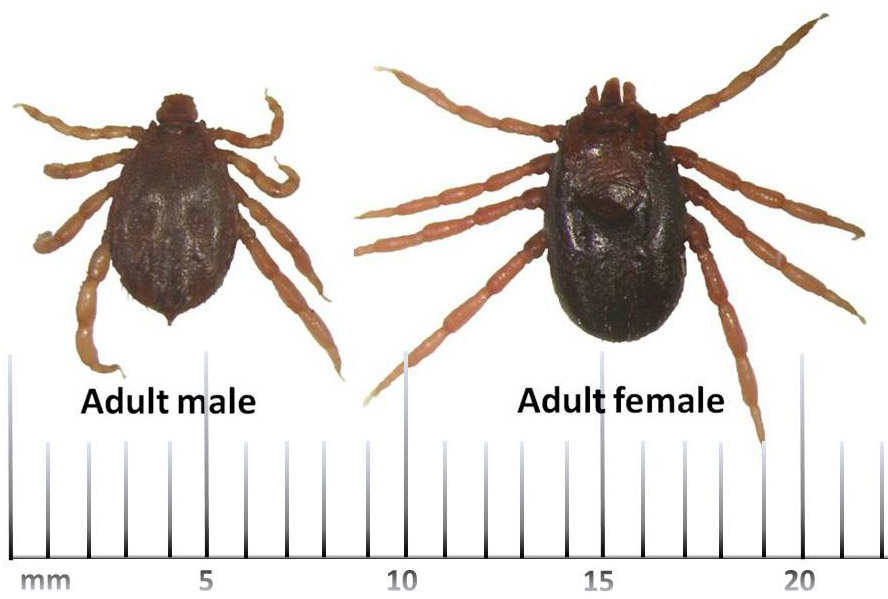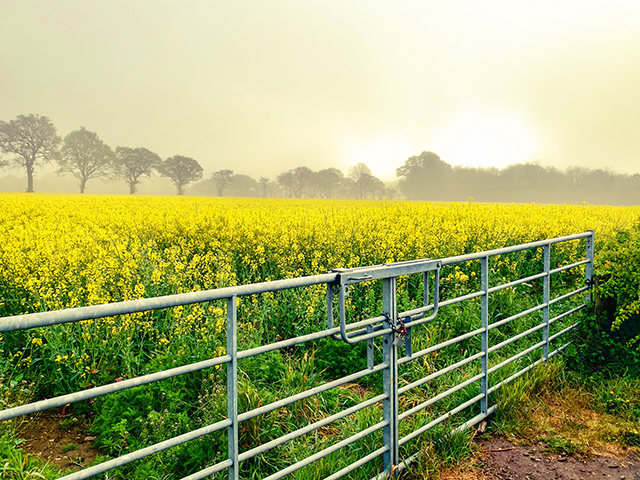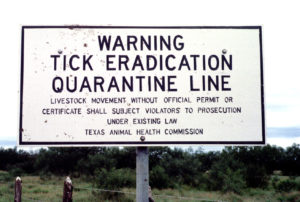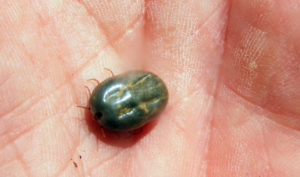Farm & Ranch
[AgriLife Today] Texas cattle fever ticks are back with a vengeance

By: Steve Byrns
Writer: Steve Byrns, 325-653-4576, [email protected]
Contacts: Dr. Pete Teel, 979-845-3253, [email protected]
Dr. Sonja Swiger, 254-968-4144, [email protected]
COLLEGE STATION– Texas cattle fever ticks, which made Texas longhorns the pariah of the plains in the late 1800s, are once again expanding their range with infestations detected in Live Oak, Willacy and Kleberg counties, said Texas A&M AgriLife experts.
As of Feb. 1, more than 500,000 acres in Texas are under various quarantines outside of the permanent quarantine zone.
Dr. Pete Teel, Texas A&M AgriLife Research entomologist at College Station, said the vigilance and cooperation of regulatory agencies, namely the Texas Animal Health Commission and the U.S. Department of Agriculture and the Animal and Plant Health Service, in collaboration with the livestock and wildlife industries are needed to detect, contain and eliminate cattle fever ticks.
Because there is no cure for tick fever, a series of quarantine levels are used to prevent animal movement and the spread of a fever tick infestation, and to permit animal treatments for tick elimination. For an explanation of these quarantines see http://bit.ly/2jkqTNX.
Pictured, is a cattle fever tick quarantine road sign in South Texas. (Texas A&M AgriLife photo)
“We’ve been responding to calls for several weeks now stemming from this outbreak,” said Dr. Sonja Swiger, AgriLife Extension veterinary entomologist at Stephenville.
“Most of Texas has been shielded from this problem for so long that there is little memory of what it took to be able to enjoy the benefit,” she said. “Now when producers are confronted with the issue without knowledge of the history and biology and risks associated with cattle fever, they are overwhelmed.”
Teel said the historic cattle drives from Texas to railheads in Missouri and Kansas in the late 1800s brought unwanted attention when local cattle died of a strange fever associated with the arrival of Texas cattle.
“Texas cattle fever was ultimately linked to ticks brought along by the Texas longhorns,” Teel said. “These ticks were appropriately named Texas cattle fever ticks, due to their ability to transmit a fever-causing agent from infected to uninfected cattle.”
By 1906, Teel said, it was determined these ticks and Texas cattle fever were found throughout 14 southern states and were limiting the economic development of the region. It was also discovered that procedures separating cattle from these ticks was essential to disease prevention and tick elimination.
“State and federal eradication programs with industry support began in 1906 and slowly eradicated the disease by eliminating these specific ticks from the eastern seaboard to the Texas-Mexico border, a task declared completed in the 1940s,” he said. “A permanent buffer zone was created and has been maintained ever since along the international border from Del Rio to the mouth of the Rio Grande to prevent re-establishment of ticks from Mexico where both ticks and pathogens remain.”
Since the 1970s, there have been periodic incursions of these ticks into Texas. One such incursion is happening now, requiring quarantine and eradication to prevent their spread, he said.
“However, the success of this program has protected our cattle industry from the risks of disease outbreaks by preventing contact with the tick vector for so long that most people do not remember the tremendous effort and significant benefits, and are often unaware that this risk still exists,” Teel said.
“Decades of changes in land-use, brush encroachment, expansion of native and exotic game, diversification of animal enterprises and variation in climatic cycles are contributing to new challenges in keeping this problem at bay.”
How risky is the disease? Teel said the Southern Region of the U.S. is home to more than 400,000 cattle operations producing a third of all fed cattle in the country. This region is the original distribution location of these ticks before the eradication program, and climate modeling indicates it would still support these ticks today.
Mortality in cattle without prior exposure to the disease is estimated to range from 70-90 percent. There are no protective vaccines and no approved drugs to treat sick animals in the U.S., he said. The U.S. Department of Agriculture has estimated that if eradication of these ticks had not occurred, cattle industry losses across the southern U.S. today would be about $1 billion annually.
The technical name for Texas cattle fever is bovine babesiosis, a name related to the organisms that infect the red blood cells of cattle. It is their destruction of the red blood cells that results in anemia, fever and death, Swiger said.
“There are two closely related tick species capable of transmitting these pathogens, one called ‘the cattle tick,’ Rhipicephalus (Boophilus) annulatus, and the other called ‘the southern cattle tick,’ R. microplus,” she said. “Both of these tick species and associated pathogens were introduced to the Western Hemisphere on livestock brought by early explorers and settlers from different parts of the world.”
The origin of the cattle tick is the Mediterranean area where climates are relatively temperate, while the southern cattle tick is from the tropics of the Indian sub-continent. Thus, they were both successful in adapting to the southern climates of the U.S., as well as similar climates in Mexico, Central and South America, Teel said.
Teel said fever ticks remain on the same animal through their larval, nymphal and adult stages all the way through until the blood-engorged females drop off the host animal. Once off the host, females lay from 2,500-4,000 eggs, and then die. The males remain on the animal to mate with more females. It takes 20 days from the time the larvae arrive on the host animal until the first females start dropping off with the most females leaving the host at about Day 25. So, animal movement during this period allows ticks to be dropped into new locations.
“A successful hatch depends on moderate temperatures and high relative humidity more common to tree and brush covered areas than to open meadow or grass habitats,” Teel said. “If ticks pick up the pathogen from their host during blood feeding, the pathogen is passed through the egg to the larvae of the next generation. No other tick species in the U.S. are capable of transmitting the pathogen of Texas cattle fever.
“Cattle are the preferred host and back when cattle were basically the only host, the ticks were much easier to control,” he said. “Today white-tailed deer and several exotic ungulates including nilgai antelope serve as hosts. Nilgai, an imported exotic species that have naturalized in much of South Texas, are native to India and were historically noted as a host animal for the southern cattle tick in India. So what we’ve done is bring both the ticks and nilgai together again.”
While there are many challenges to optimizing tick suppression where there is a mix of cattle, wildlife and feral ungulate hosts, Teel said research and technology development are providing new tools to meet these challenges.
“AgriLife Research and the USDA’s Agricultural Research Service are collaborating to discover new and improved methods of detecting and eliminating cattle fever ticks,” he said. “These efforts include mining sequences of the DNA of both tick species to discover sites to disrupt functions such as tick feeding or egg laying, to identify targets for new pesticides, or genetic approaches for tick suppression or prevention of pathogen transmission.
“There is evidence that the manure of tick-infested cattle contains detectable differences in chemical makeup compared to non-infested animals and may provide for improved methods of tick detection,” he said. “And, the complex interactions of tick-host-habitat-climate relationships through simulation modelling are currently being investigated to improve tactics and strategies for tick elimination where both wildlife and cattle are involved.”
To learn more, Teel and Swiger recommend using Tick App, a free smartphone application available at http://tickapp.tamu.edu, and the Texas Animal Health Commission’s website athttp://www.tahc.texas.gov/regs/code.html for information on tick treatment options, tick quarantine and associated regulations, as well as the latest updates on current quarantines.
-30-
Find more stories, photos, videos and audio at http://today.agrilife.org
Farm & Ranch
Meanwhile, Back at the Ranch…

By Rayford Pullen | [email protected]
When May arrives, we start thinking about weed control. With two years of drought under our belts, grass grazed short and hay stocks depleted, what we do now will influence our forage conditions for the entire year. With 75 percent of our annual warm season forages made by July 15 in North Texas, we need to get the grass growing while the sun shines.
Speaking of the sun shining, the biggest deterrent to growing lots of grass is restricted sunlight, and the biggest sun blockers we have are weeds.
Have you noticed weeds are normally just slightly taller than your grass and are probably blocking 90 percent of the sunlight from reaching the grass itself? So obviously, we need to improve conditions, so sunlight reaches the plants we want to grow.
With grass extremely short, more sunlight is hitting the soil surface now, which in turn results in more weed seed germinating. With the moisture we have received, we expect an abundance of weeds this year.
To read more, pick up a copy of the May issue of NTFR magazine. To subscribe by mail, call 940-872-5922.
Farm & Ranch
Land Market Report: March Land Sales

By Jared Groce
Rural land sales are continuing on a steady pace for early spring, with prices holding very strong with the sell-to-list price ratios remaining very high, even on properties that have been on the market for a longer than usual time period. The total number of transactions are picking up once again as the spring selling season kicks off, and the average acreage continues to decrease.
Larger acreage properties seem to be in higher demand than smaller properties currently, with many buyers simply parking cash in real estate to hedge against inflation. Interest rates seem to have settled down and most experts agree that rates will be reduced by the fed this year. Some lenders have programs in place that allow the buyer to reduce their rates without having to go through a full refinance ordeal.
To read more, pick up a copy of the May issue of NTFR magazine. To subscribe by mail, call 940-872-5922.
Farm & Ranch
Texas FFA State Vice President Weston Parr

Future Farmers of America was founded by a group of farmers in 1928 with the mission of preparing the next generation of agriculture. It has done just that during its 95-year history, as the organization works to give back to others by following its motto, “learning to do, doing to learn, earning to live, living to serve.”
FFA is an organization made up of state associations, and at the helm of the Texas FFA is a team of 12 officers representing their respective areas within the Lone Star State. These individuals dedicate a year of their lives as they serve members, provide leadership, and work together with the state staff and board of directors to develop policy and lead the organization of over 177,000 members.
North Texas is represented by Area IV and Area IV, stretching from Wilbarger County to Bell County and from Runnels County to Grayson County. This year, those chosen to lead this great area are State President Isaac Hawkins Jr., Area IV, and State Vice President Weston Parr, Area V.
Parr is from the Sam Rayburn FFA chapter and the Area V Association, but the leader who now serves more than 19,100 members of Area V entered the FFA organization as a shy teenager who sat in the back of the room.
“I didn’t talk to a whole lot of people. I didn’t know what I wanted to do with my life or where I could see myself, so I wasn’t involved on my high school campus,” Parr recalled.
“Then I started FFA and slowly but surely, my ag teachers worked me into attending more contests, meeting new people, and speaking. I remember the first time I gave an officer speech to my chapter. I can still remember how embarrassing it was. To see the progression from that moment to speaking on stage at the state convention in front of thousands of people. Now I feel like I can enter the industry I want and be successful all because of what FFA afforded me for five years.”
There is not much Parr did not do during his time in high school. His contest participation included chapter conducting, wool judging, cotton judging, wildlife, and job interview, but his favorite was extemporaneous speaking, which he did not start until his senior year of high school.
“I wish I could go back to my freshman, sophomore, and junior years and start that sooner. I think if I had more time, I would have been more successful than I already was, but that was something I didn’t realize I liked at the time. I’m not naturally somebody who likes to speak in public, but it was actually my favorite,” Parr said.
Parr won several awards during his time competing. In 2023 alone, Parr earned the Texas FFA Service-Learning Proficiency title, was a National FFA Service-Learning Proficiency finalist, and a Texas FFA Extemporaneous Speaking finalist. In addition to his CDE and LDE events during high school, he showed commercial steers at Houston, and boilers at most major shows, participated in the county show with projects in ag mechanics, showed goats from time to time, and showed heifers until graduation.
“FFA provides invaluable resources and knowledge to be successful once you leave high school and you are out of the blue jacket for the first time. I have been a part of a lot of great organizations over the years, and they are all great in their own way, but in my opinion, FFA is the most successful at producing members of society who want to go and do something with themselves,” Parr said.
He was halfway through his time as Area V Association President and attending the national convention when he began to ponder the idea of running for state office.
“This is around the time when you usually figure out if you want to go through and be a state officer or you decide that area officer is your last run. I was unsure of where I wanted to go, but I knew I didn’t want to be done with FFA. I decided maybe it would be a good opportunity not only for me to make more friendships and connections, but also to give back to the program that allowed me to be able to do what I can do today,” Parr explained.
To read more, pick up a copy of the May issue of NTFR magazine. To subscribe by mail, call 940-872-5922.
-

 Country Lifestyles1 year ago
Country Lifestyles1 year agoScott & Stacey Schumacher: A Growth Mindset
-

 Equine8 months ago
Equine8 months agoThe Will to Win
-

 Country Lifestyles7 years ago
Country Lifestyles7 years agoStyle Your Profile – What your style cowboy hat says about you and new trends in 2017
-

 Country Lifestyles4 years ago
Country Lifestyles4 years agoAmber Crawford, Breakaway Roper
-

 HOME7 years ago
HOME7 years agoGrazing North Texas – Wilman Lovegrass
-

 Country Lifestyles7 years ago
Country Lifestyles7 years agoDecember 2016 Profile, Rusty Riddle – The Riddle Way
-

 Outdoor9 years ago
Outdoor9 years agoButtercup or Primrose?
-

 Country Lifestyles8 years ago
Country Lifestyles8 years agoJune 2016 Profile – The man behind the mic: Bob Tallman








